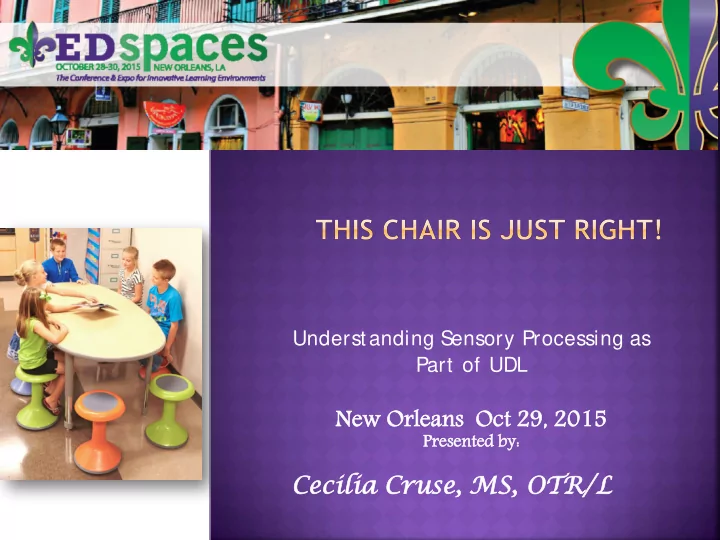

Underst anding S ensory Processing as Part of UDL Ne New O Orleans ns Oct 29, 29, 2015 2015 Presen sented b by: Ceci cilia C Cruse se, MS, S, O OTR/L
The organization of sensation for use Visual, tactile, auditory, olfactory& gustatory The hidden senses: Vestibular, proprioceptive Adaptive response.
Visual System: Acuity Visual perception Auditory System: Acuity Auditory perception Most commonly used systems for teaching yet only 40% students are visual learners and only 12% are auditory learners.
Tactile System: Light touch, pressure, vibration, temperature and pain Types of touch: protective Discriminative Body awareness and motor planning
Vestibular System: Movement, gravity and changing head position Impacts: vision, posture, balance, movement and helps regulate behavior Receptors in semicircular canal in ears
Proprioceptive System: Information from the muscles and joints Awareness of body position Receptors located in muscles, tendons, joints and deep in the skin Helps create a body scheme Certain types of proprioceptive input help regulate alert state
The inability to modulate, discriminate, coordinate or organize sensations adaptively. Life becomes a rush hour traffic jam! 5-15% of school age children(UCSF July 2013) DSM V (May 2013) includes some characteristics of children with SPD but only as it relates to revised definition of autism
http:/ / edorigami.wikispaces.com/ 21st+Century+Pedagogy I would add Sensory Processing as well when planning 21 st Icentury classroom design. As an OT , I would add S ensory Processing as well!
All Types of Sensory Input is Needed to Support Attention, Learning and Behavior Use sensory strategies to enhance learning and to meet student’s sensory needs.
Attention Span Movement Input Fidgets Quiet Regrouping Staying on Time/Space Task Oral Motor Tools Heavy Work Input Preventing Transition Meltdowns Strategies Alt. Positioning
Vestibular System
Cycling (Movement) helps with Brain Function. S hown: KidsFit Pedal Desk www.youthfit.com “ Cycling anchors learning when more of the senses are involved to increase the executive function of the frontal lobe.” The frontal lobe is like the CEO of the brain. “ - Lowell Lease, KidsFit
Prefrontal Cortex =Executive Function or CEO Emotional Responses Attention/ Maintaining Focus Behavior & Judgement Planning & Organization Initiate or Delay Response Consequence Evaluation Learning from Mistakes Dysfunction in these areas can lead to disruption in the organization and control of behavior Cerebellum also helps process vestibular input to help with posture, balance coordination, speech and vision
Exercise Is ADHD Medication Physical movement improves ment al focus, memory, and cognit ive flexibilit y; new research shows j ust how crit ical it is t o academic performance. ht t p:/ / www.t heatlant ic .com/ healt h/ archive/ 20 14/ 09/ exercise-seems- t o-be-beneficial-t o- children/ 380844/
NeoMove
Proprioceptive Input S patial Boundaries Defined Womb S pace Cave S pace Allows for regrouping When used as part of a good sensory diet in the classroom it can help prevent meltdowns
Proprioceptive Input Joint Compression Deep Touch Pressure Occupational Therapist & Neurobiologist Kim Barthel http:/ / kimbarthel.ca/ Self Regulation
Weighted Lap Pads Weighted Vests Weighted Dress Up Clothing
Proprioceptive SqUoosh Input Chair Helps Define Spatial Boundaries PeaPod
Dream Chair Fluff Chair Soft Seating Ethos Chair
Multisensory Environment MSE, MSR, Sensory Rooms Snoezelen
Controlled environment to promote calming, controlled sensory input (visual, auditory, olfactory, vestibular, proprioceptive) Demand growing 15% in last 5 years Roughly 2,000 MSE’s now in USA. Used in Europe for much longer. Increase in use with ASD but also EBD issues, and even geriatrics with Alzheimer's/Dementia etc. Also opportunities for cognitive skills/cause/effect Becoming part of inclusion for multisensory approach to learning
The McNamara Boeing 787: Tunnel: Dreamliner Detroit Airport Hotel/ Office Lobbies Photo: Midwest Tropical
Biehl, Lindsey & Peske, Nancy. Raising A Sensory Smart Child. New York: Penguin Books 2009. Cruse, Cecilia. “ Sensory Solutions in the Classroom”: SEEN Magazine, Winter 2014 p. 45-46 Henry, Diana, MS, OTR/L. SI Toolkit: www.ateachabout.com Isbell, Christie & Isbell, Rebecca. Sensory Integration: A Guide for Pre-School Teachers. Beltsville, MD: Gryphon House 2007. Jensen, Eric. Environments for Learning. San Diego: The Brain Store, 2003. MSE: American Assoc of MSE: http://www.aamse.us/ http://www.disabilityscoop.com/2014/12/05/sensory-rooms-popularity/19895 Schiller, Pam. Start Smart! Building Brain Power in the Early Years. Beltsville, MD: Gryphon House, 2012 Schneider, Catherine Chemin, OTR: Sensory Secrets. Siloam Springs, AR:Concerned Communications, 2001 Products: www.schoolspecialty.com
“You may be disappointed if you fail, but you are doomed if you don’t try.” - Beverly Sills
Recommend
More recommend